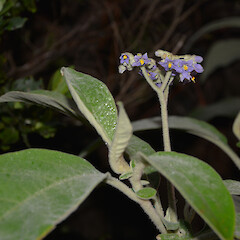Solanum mauritianum
Common name
woolly nightshade
Family
Solanaceae
Flora category
Vascular – Exotic
Structural class
Trees & Shrubs - Dicotyledons
NVS code
The National Vegetation Survey (NVS) Databank is a physical archive and electronic databank containing records of over 94,000 vegetation survey plots - including data from over 19,000 permanent plots. NVS maintains a standard set of species code abbreviations that correspond to standard scientific plant names from the Ngä Tipu o Aotearoa - New Zealand Plants database.
SOLMAU
Conservation status
Not applicable
Habitat
Terrestrial. A lowland plant. The plant occurs in scrub and forest margin and shrubland communities. Invades pastoral land, native forest margins and urban areas.
Detailed description
Spreading unarmed shrub or small tree to 10m tall and with trunk to 15cm diam., with all parts stellate-tomentose, the hairs generally sessile to long-stalked. Leaves on vegetative and most flowering shoots with prominent stipule-like auricles 5~25mm long at base; petioles to 6mm long on flowering shoots, longer on strong vegetative shoots. Lamina 10~25 x 3.5~10cm, ovate to elliptic, entire, light to dark green on upper surface, white to yellowish-green on lower surface; base cuneate; apex usu. acuminate but blunt at tip. Panicles dense, many-flowered, corymbose, terminal at first; rachis to 18cm long, stout; pedicels generally erect at fruiting. Calyx approx. 5mm long, not accrescent; lobes mainly elliptic. Corolla 1.5~2cm diam., usu. mauve to purple, occasionally white; lobes ovate or triangular-ovate, stellate-tomentose outside. Anthers 2~3mm long. Berry approx. 1cm diam., globose, dull yellow; stone cells 0. Seeds 1~2mm long, oblong-obovoid to suborbicular. (-Webb et. al., 1988)
Similar taxa
Shrub or small tree up to 10m; trunk up to 20cm in diameter; leaves are ovate and grey-green on the upper surface, densely covered in felt-like hairs; leaves (commonly 10-25cm long and 3.5-10cm wide) have a very pungent smell; flowers (1.5-2cm diameter) have 5 purple lobes with a yellow centre; berries (1cm diameter) are green ripening to yellow; each berry contains many seeds (1-2mm long). Soft wooded tree.
Flowering
January, February, March, April, May, June, July, August, September, October, November, December
Flower colours
Violet/Purple, White
Life cycle
Perennial. Trees lose vigour after 15 years and die branch by branch. Seedlings established in summer can bear flowers by the autumn. Persistent seed bank (Fromont and King, 1992). Seed is bird dispersed. Although the majority of the fruit fall to the ground beneath the parent plant, many berries are eaten by birds and seed dispersed this way.
Year naturalised
1883
Origin
S Brazil, Uruguay
Reason for introduction
Ornamental
Tolerances
The plant has the ability to resprout after physical damage. Moderate tolerance to shade; tolerant to frost; moderate moisture tolerance (Fromont and King, 1992). Requires medium to high soil fertility (Atkinson 1997).
Etymology
solanum: Derivation uncertain - possibly from the Latin word sol, meaning “sun,” referring to its status as a plant of the sun. Another possibility is that the root was solare, meaning “to soothe,” or solamen, meaning “a comfort,” which would refer to the soothing effects of the plant upon ingestion.
National Pest Plant Accord species
This plant is listed in the 2020 National Pest Plant Accord. The National Pest Plant Accord (NPPA) is an agreement to prevent the sale and/or distribution of specified pest plants where either formal or casual horticultural trade is the most significant way of spreading the plant in New Zealand. For up to date information and an electronic copy of the 2020 Pest Plant Accord manual (including plant information and images) visit the MPI website.
Poisonous plant
The globular yellow berries are poisonous if eaten.

















